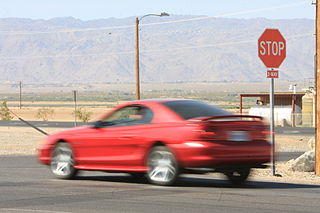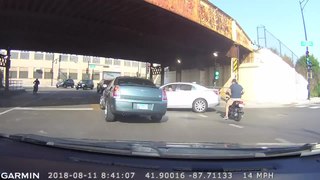Related Research Articles
Life imprisonment is any sentence of imprisonment for a crime under which convicted people are to remain in prison for the rest of their natural lives or indefinitely until pardoned, paroled, or otherwise commuted to a fixed term. Crimes for which, in some countries, a person could receive this sentence include murder, torture, terrorism, child abuse resulting in death, rape, espionage, treason, drug trafficking, drug possession, human trafficking, severe fraud and financial crimes, aggravated criminal damage, arson, kidnapping, burglary, and robbery, piracy, aircraft hijacking, and genocide, crimes against humanity, war crimes, severe cases of child pornography, or any three felonies in case of three-strikes law. Life imprisonment can also be imposed, in certain countries, for traffic offences causing death. Life imprisonment is not used in all countries; Portugal was the first country to abolish life imprisonment, in 1884.

Driving under the influence (DUI) is the offense of driving, operating, or being in control of a vehicle while impaired by alcohol or drugs, to a level that renders the driver incapable of operating a motor vehicle safely. Multiple other terms are used for the offense in various jurisdictions.
Vehicular homicide is a crime that involves the death of a person other than the driver as a result of either criminally negligent or murderous operation of a motor vehicle.

A moving violation is any violation of the law committed by the driver of a vehicle while it is in motion. The term "moving" distinguishes it from other motor vehicle violations, such as paperwork violations, parking violations, or equipment violations. The United States Department of State makes reference to moving violations in its enforcement guidance.

The Theft Act 1968 is an Act of the Parliament of the United Kingdom. It creates a number of offences against property in England and Wales. On 15 January 2007 the Fraud Act 2006 came into force, redefining most of the offences of deception.

Road rage is aggressive or angry behavior exhibited by motorists. These behaviors include rude and verbal insults, yelling, physical threats or dangerous driving methods targeted at other drivers, pedestrians or cyclists in an effort to intimidate or release frustration. Road rage can lead to altercations, damage to property, assaults, and collisions that result in serious physical injuries or even death. Strategies include cutting motorists off, inappropriate honking, flipping off another driver, swerving, tailgating, brake checking, and attempting to fight.
In England, Wales and Northern Ireland taking without owner's consent (TWOC), also referred to as unauthorised taking of a motor vehicle (UTMV) describes any unauthorised use of a car or other conveyance that does not constitute theft. A similar offence, known as taking and driving away, exists in Scotland.
Many countries have adopted a penalty point or demerit point system under which a person’s driving license is revoked or suspended based on the number of points they’ve accumulated over a specific period of time, points are given for traffic offenses or infringements committed by them in that period. The demerit points schemes of each jurisdiction varies. These demerit schemes are usually in addition to fines or other penalties which may be imposed for a particular offence or infringement, or after a prescribed number of points have been accumulated.
In the English law of homicide, manslaughter is a less serious offence than murder, the differential being between levels of fault based on the mens rea or by reason of a partial defence. In England and Wales, a common practice is to prefer a charge of murder, with the judge or defence able to introduce manslaughter as an option. The jury then decides whether the defendant is guilty or not guilty of either murder or manslaughter. On conviction for manslaughter, sentencing is at the judge's discretion, whereas a sentence of life imprisonment is mandatory on conviction for murder. Manslaughter may be either voluntary or involuntary, depending on whether the accused has the required mens rea for murder.

In United States law, reckless driving is a major moving violation related to aggressive driving that generally consists of driving a vehicle with willful or wanton disregard for the safety of persons or property. It is usually a more serious offense than careless driving, improper driving, or driving without due care and attention, and is often punishable by fines, imprisonment, or the suspension or revocation of one's driver's license. In Commonwealth countries, the offense of dangerous driving applies.
In India, a driving licence is an official document that authorises its holder to operate various types of motor vehicles on highways and some other roads to which the public has access. In various Indian states, they are administered by the Regional Transport Authorities/Offices (RTA/RTO). A driving licence is required in India by any person driving a vehicle on any highway or other road defined in the Motor Vehicles Act, 1988. This act sets limits on the minimum age for vehicle operation ranging from 16 to 20, depending on specific circumstances. A modern photo of the driving licence can also serve many of the purposes of an identity card in non-driving contexts such as proof of identity or age.
The Highway Traffic Act (HTA) is legislation in Ontario, Canada, which regulates the licensing of vehicles, classification of traffic offences, administration of loads, classification of vehicles and other transport-related issues. First introduced in 1923 to deal with increasing accidents during the early years of motoring in Ontario, and replacing earlier legislation such as the Highway Travel Act, there have been amendments due to changes to driving conditions and new transportation trends. For example, in 2009, the Act was revised to ban the use of cell phones while driving.
In United Kingdom law, dangerous driving is a statutory offence related to aggressive driving. It is also a term of art used in the definition of the offence of causing death by dangerous driving. It replaces the former offence of reckless driving. Canada's Criminal Code has equivalent provisions covering dangerous driving.
Impaired driving is the term used in Canada to describe the criminal offence of operating, having care or the control of a motor vehicle while the person's ability to operate the motor vehicle is impaired by alcohol or a drug. Impaired driving is punishable under multiple offences in the Criminal Code, with greater penalties depending on the harm caused by the impaired driving. It can also result in various types of driver's licence suspensions.
The laws of driving under the influence vary between countries. One difference is the acceptable limit of blood alcohol content before a person is charged with a crime.
Driving without due care and attention or careless driving is a legal term for a particular type of moving traffic violation related to aggressive driving in the United States, Canada, the United Kingdom, and Ireland. It is often punishable by fines or endorsements like suspensions on a driver's license.

In traffic laws, a hit and run or a hit-and-run is the criminal act of causing a traffic collision and not stopping afterwards. It is considered a supplemental crime in most jurisdictions.
Causing bodily harm by wanton or furious driving is a statutory offence in England and Wales and Northern Ireland. It has been abolished in the Republic of Ireland.

Drug-impaired driving, in the context of its legal definition, is the act of driving a motor vehicle while under the influence of an impairing substance. DUID, or Driving Under the Influence of Drugs, is prohibited in many countries. Several American states and European countries now have "per se" DUID laws that presume a driver is impaired if they are found to have any detectable quantity of controlled substances in their body while operating an automobile and that the driver has no doctor's prescription for the substance. This is similar to the "per se" DUI/DWI laws that presume a driver is impaired when their blood alcohol content is above a certain level. There is some controversy with "per se" DUID laws in that a driver with any detectable quantity of controlled substances may not in fact be impaired and the detectable quantity in blood or sweat may be only the remnants of drug use in days or weeks past. It is against road traffic safety. Research on factors associated with engaging in DUID is receiving increasing attention to develop more effective countermeasures.
Manslaughter is a crime in the United States. Definitions can vary among jurisdictions, but manslaughter is invariably the act of causing the death of another person in a manner less culpable than murder. Three types of unlawful killings constitute manslaughter. First, there is voluntary manslaughter which is an intentional homicide committed in "sudden heat of passion" as the result of adequate provocation. Second, there is the form of involuntary manslaughter which is an unintentional homicide that was committed in a criminally negligent manner. Finally, there is the form of involuntary manslaughter which is an unintentional homicide that occurred during the commission or attempted commission of an unlawful act which does not amount to a felony.
References
- ↑ Section 1 Road Traffic Act 1991
- ↑ The Road Traffic Offenders Act 1988, Part I of Schedule 2 (as amended by the Criminal Justice Act 2003, section 285(3))
- ↑ The Road Traffic Offenders Act 1988, sections 34(1) and (4) and Part I of Schedule 2
- ↑ "Causing death by dangerous driving – Sentencing" . Retrieved 22 May 2023.
- ↑ "Road traffic offences: Police, Crime, Sentencing and Courts Bill 2021 factsheet". GOV.UK. Retrieved 22 May 2023.
- ↑ The Road Traffic Offenders Act 1988, section 44 and Part I of Schedule 2
- ↑ The Road Traffic Offenders Act 1988,section 28 and Part I of Schedule 2
- ↑ Cooksley & Anor v R [2003] EWCA Crim 996 (3 April 2003)
- ↑ Richardson & Ors, R v [2006] EWCA Crim 3186 (18 December 2006)
- ↑ England and Wales: S.I. 1993/1968, art. 2(1) & Sch.1; Scotland: S.I. 1993/2035, art. 2(1)
- ↑ "Hong Kong e-Legislation". www.elegislation.gov.hk. Retrieved 12 June 2023.
- ↑ Hall Williams, J. E. (1963). "Causing Death by Dangerous Driving. The Objective Test". The Modern Law Review. 26 (4): 430–433. JSTOR 1093215.
- ↑ Ronald Bell (17 July 1962). "New Clause.—(REPEAL OF s.1. OF 8 & 9 ELIZ, 2 c.16.)". Parliamentary Debates (Hansard) . United Kingdom: House of Commons. col. 334–345.
- ↑ Ontario Ministry of Transportation: "Other Ways to Lose your Licence"
- ↑ Ontario: "What happens if I get out-of-province demerit points?"